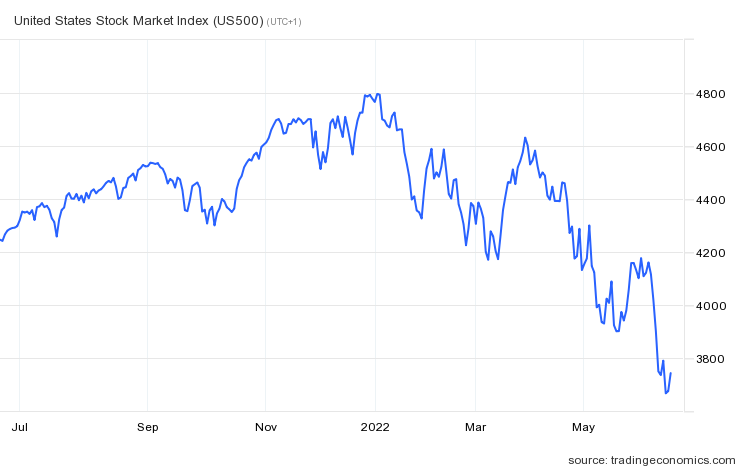- A bear market occurs when a market experiences prolonged price declines.
- Factors such as a weak or slowing economy or shocks like pandemics or war can all contribute to a bear market.
- In contrast, a bull market is when stocks are rising – or expected to rise – over a prolonged period.
US stocks entered bear market territory last week. The S&P 500 index fell by 3.9% on Monday 13 June to close at its lowest point since January 2021. This also left the index more than 20% below where it was in January of this year, a level of decline typically considered a bear market , The Financial Times reported. The fall followed similar drop in May.
But what does this mean? And what causes bear markets?
What is a bear market?
A bear market When a market trials prolonged price declines occurs. “It typically describes a condition in which securities prices fall 20% or more from highs amid widespread pessimism and negative investor sentiment,” writes Investopedia.
Bear markets are often associated with declines in an overall market or index – such as the S&P 500 – but can also be connected with individual securities or commodities.
They can also be associated with an economic downturn such as a recession.
However, the 20% mark is generally considered fairly arbitrary. “It’s a shortcut in language around the financial markets that people use,” Charlie Fitzgerald III, a Florida-based certified financial planner, told CNBC in May when stocks also slid into bear market territory. “The bottom line is, it’s a tough time.”
At the World Economic Forum’s Annual Meeting at Davos, Stefan Marcu, a Senior Partner at global management consulting firm Kearney, said: “It’s a market of commodities right now, of agricultural commodities, of metals. It’s not a market that’s conducive to collecting capital for growth, unfortunately. Let’s hope it’s short-lived.”
Companies that don’t have solid fundamentals could “face significant issues over the next couple of months or years”, he added. Depending on how long it lasts, it could start to have an impact on job markets or job security.
What causes a bear market?
The causes can vary, writes Investopedia. However, in general, a weak or slowing economy or factors such as pandemics, war or bursting market bubbles can play a role. Unexpectedly high inflation figures in the US triggered last week’s selling, The Financial Times reported.
CNBC reported in May that Wall Street is feeling the effects of a number of factorsincluding high inflation and associated interest rates, the war in Ukraine and fears of a recession.
How are frequent bear markets?
Bear markets aren’t uncommon, explains CNBCwith the last occurring in US stock markets at the outbreak of the COVID-19 pandemic in early 2020.
Other notable examples of bear markets, according to Investopedia, include after the dotcom bubble burst in 2000 and the Great Depression of the 1920s.
So what’s a bull market?
Bear markets are often contrasted with bull markets, which represent a condition under which prices are rising or expected to rise, Investopedia says. Given the natural volatility of stock markets, bull markets typically refer to more extended periods of price rises – lasting months or years.
A notable example of the US bull market came after the stagflation period in 1982, which ended with the bursting of the dotcom bubble in 2000.
.


